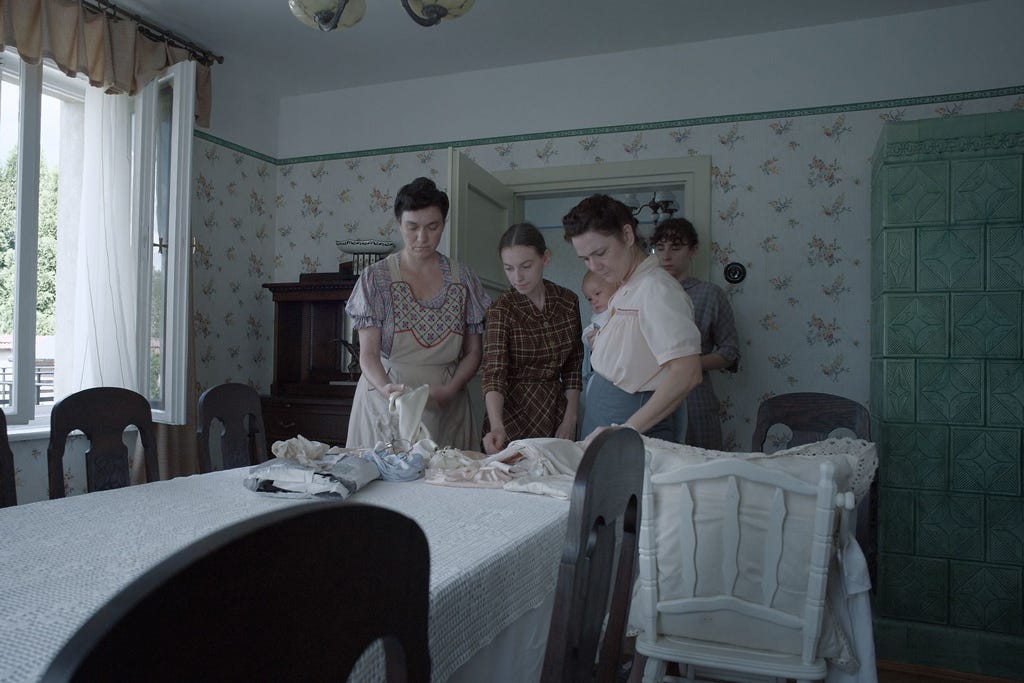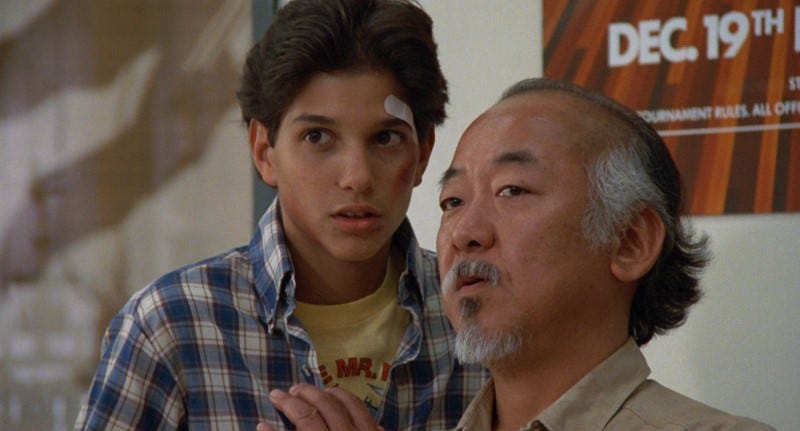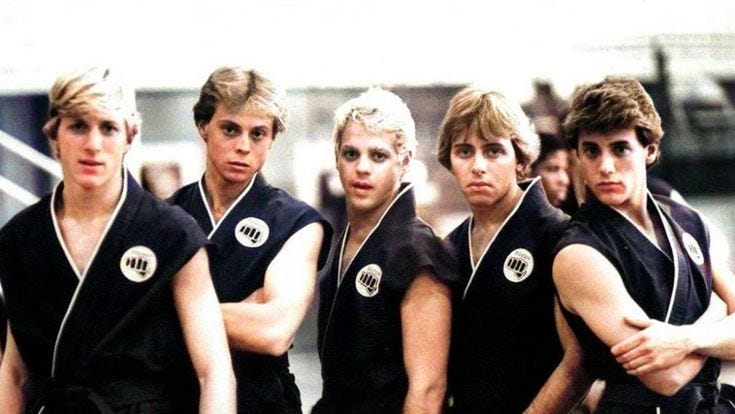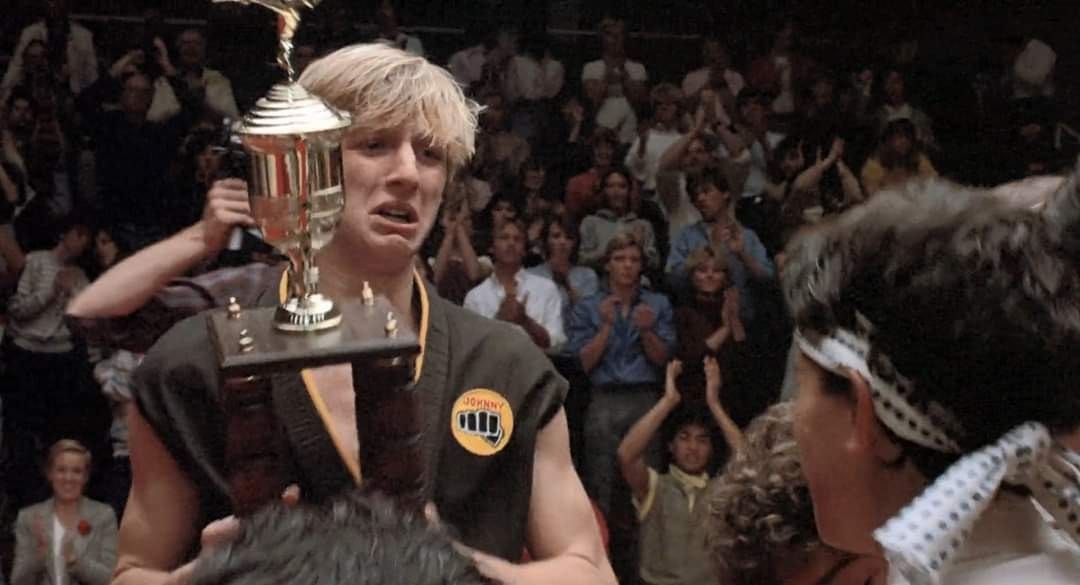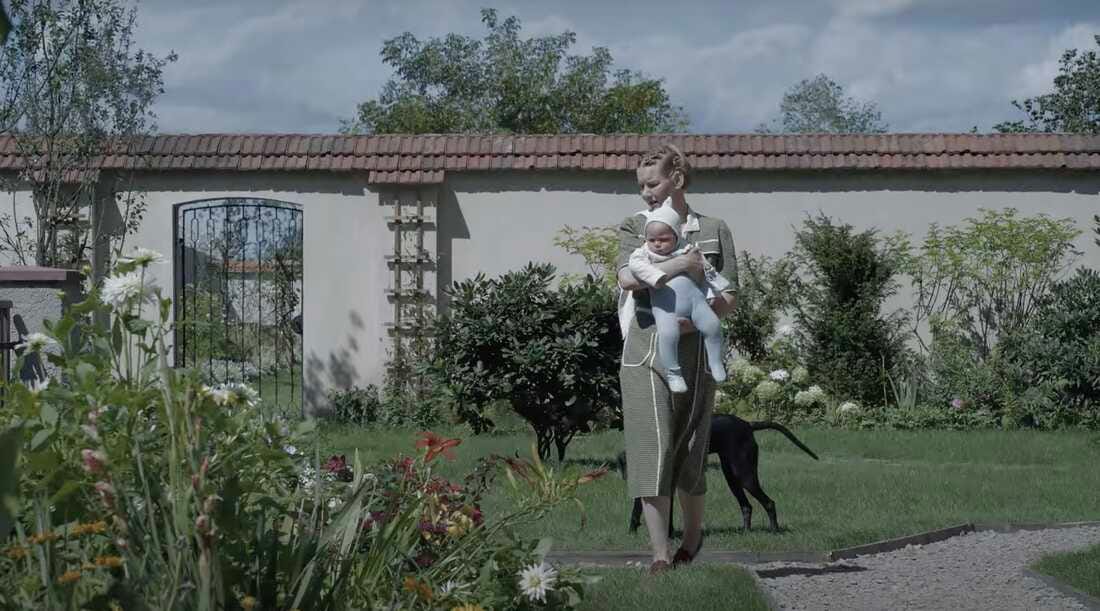The Zone of Interest, The Karate Kid, and the Fascist Language of Filmmaking
Jonathan Glazer, writer and director of the existential waking nightmare The Zone of Interest, told The Guardian he wanted the film to feel “un-authored.” He said to Screen Daily he wanted to “remove as much of the artifice of filmmaking as possible,” and in that same chat, called the tools of filmmaking “fetishized.”
Which is all well and good, but what does any of that actually mean?
The Zone of Interest follows the family of a Nazi commondant in charge of operations at the Auschwitz concentration camp, conveniently located across their garden wall. The film, however, makes no attempt to depict the atrocities occurring on the other side. We instead have our gaze fixed uncomfortably on the family’s banal suburban life, trying to eke out what feels suspiciously like the “American Dream” while living in denial of their complicity.
Practically, what you get as an actual movie is something akin to “Big Brother in the Nazi house,” in Glazer’s own words. Actors and actions are presented without comment, decoration, and often context. Natural light casts blocky shadows onto footage that looks straight out of a hidden camera–and sure enough, quite a few were invisible to the performers on set. Glazer gives as much individual focus to the mocking plumes of smoke and moaning wails opposite the concentration camp wall as he does to women folding their laundry: almost none at all.
The result is a film that you don’t so much watch as you have happen to you. It engulfs you in a world of utter apathy and emptiness, with the ultimate goal being “to make it a narrative that you, the viewer, complete, that you are involved in and ask
questions of.”
With the “what” established, that still leaves us with the “why” of the situation. Why does Glazer consider the tools of film manipulative? Why is doing away with these strategies key to the message and understanding of his movie? Is this just something kind of pretentious that a film genius like him is allowed to say?
All to be answered in due time. As a famous sensei once said, “First learn stand. Then learn fly.”
The easiest way to begin is with something you definitely understand, even if you only learned it subconsciously: the “tools of cinema,” as Glazer calls them. Film language is mostly used to convey meaning and feeling in the easiest way for an audience to receive. Happy music swells when we want to feel triumph. A character is shot from below to make them appear larger and more powerful. Someone partially obscured in shadow may be hiding a secret. A person dressed in white symbolizes their purity.
When done “right”–through the lens of classical Hollywood cinema–the construction of a movie should be “invisible” (film students, take a shot). That’s a fancy way of saying you don’t see the seams, and stay immersed in the film.
Here’s the thing about film language: it is really effective. Dangerously effective, in fact. As a full audiovisual medium, movies can provoke intense feelings and beliefs. Researchers at Oxford have even taken steps toward mapping identification with film to specific regions of the brain. This, chillingly, is something that the geopolitical players of the last hundred years did not let go unnoticed. Propaganda film, to this day, is one of the most useful tools in the authoritarian arsenal. From Birth of a Nation to Triumph of the Will to Sound of Freedom, the powerful and rousing nature of movies has been used to manipulate public perception.
In Glazer’s eyes, playing a love song as two romantic leads have their meet-cute is cut from the same cloth as presenting a dictator with a booming national anthem. In both instances, we are told how we should feel about a moment. We don’t practice objectivity, and obey the filmmakers’ commands.
In other words: film language is fascist.
Now, it’s time to make the cross-country road trip from Newark to Reseda and revisit one of the most fascist Hollywood movies of all time: The Karate Kid.
I don’t know who still needs to hear this, but Johnny Lawrence is not the villain of The Karate Kid. As a matter of fact, there’s an argument that he’s one of the least culpable characters in the entire film, behind Daniel LaRusso, Mr. Miyagi, and of course John Kreese. This isn’t a new bit, either; we have an entire sequel series, Cobra Kai, dedicated to exploring this very reality. So why do audiences often come away thinking Daniel is a saint and Johnny is one of the worst bullies the 80s ever produced?
Because the film makes that decision for us.
Enter Daniel LaRusso, who this film quite literally wants you to see as the teenage Rocky Balboa. Seriously–The Karate Kid has the same director as Rocky, and that was more or less the idea during production. So effective is the dramatic framework and audiovisual storytelling of Rocky that, when our protagonist is ported into it, it completely obfuscates the fact that LaRusso is a moping, ungrateful, anti-social shit-talker.
If you think that’s harsh, let’s look objectively at some of Daniel’s actions in this film. His first bit of screen time involves complaining to his mother about moving them from New Jersey–one of Dante’s nine circles of Hell–to sunny California. Never mind that Ms. LaRusso is a widowed mother trying to make ends meet and has somehow locked down an awesome comp-sci job in the valley; Daniel is simply a poor victim in this situation. He “misses the smog,” said in a way that a child might insist a jacket isn’t making them warm after fighting with a parent about wearing one.
The next mile marker on our journey is the first beach confrontation between our love triangle of Daniel, Johnny, and Ali-with-an-I. Here we see one of the most dishonest and authoritarian depictions in the film: the arrival of the Cobra Kai students. Our karate klansmen appear dressed in uniform, rolling up on their mopeds in perfect unity to enforce order at all costs. The “Aryan karate machine” coding of our villains–in the words of Bill Simmons–is so shameless that it’s above anything that could be classified as subtext, complete with actor William Zabka’s bright blonde locks and baby blue eyes.
That means, when Daniel inserts himself into a situation he has little business getting involved in and gets his ass kicked, we immediately take his side. Johnny is a fucking asshole in this sequence, verbally assaulting his ex-girlfriend and needlessly murdering a boombox, but we have no interest in knowing who he is or what could be informing this behavior. Before he’s uttered a single word, the film has dictated its sole acceptable reading of Johnny and the Cobra Kai as fascistic karate predators.
The list of LaRusso’s misdeeds continues throughout the film, including: additional rebuffing of his loving mother in favor of a strange maintenance man; unprovoked escalation of the beef with Cobra Kai; and his own verbal abuse of Ali-with-an-I. All the while, the movie bends over backward to present Daniel as nothing but a hero.
Daniel gets a goofy, colorful Halloween costume that he can use to flirt with Ali (dressed in angelic white), while the Cobra Kai are once again in uniform and painted like literal death. He pulls a bathroom prank on Johnny, but Johnny deserves it because he’s rolling–clutch your pearls, people–a joint! Daniel gets a pass from us when he eventually explodes at Ali, the only person in school who even likes him, because we know he’s going through a hard time. The bullshit continues until the very last frames, where divine intervention heals Daniel’s wounded leg enough to win the All-Valley Tournament with a famously controversial crane-kick maneuver to the face.
We haven’t even scratched the surface of sweet Mr. Miyagi’s crimes, either. This menace’s rap sheet includes assaulting a group of teenagers, driving himself and others without a license, exploiting child labor, and of course furnishing a minor with alcohol. However, just like Daniel, we extend grace to Mr. Miyagi. We know he’s had a difficult, harrowing life. We get his backstory, his journey, his trials and tribulations. Heartbreak and redemption. The movie is making a moral decision for us; our characters are justified in their actions.
That’s what makes it so jarring when, referring to Johnny Lawrence, Mr. Miyagi says, “There are no bad students, only bad teachers.” It’s the one moment where the double standard falls away, and we see the insidious seams of this propaganda film.
As most viewers know, the truest bastard in the Karate Kid cinematic universe is John Kreese, the original sensei of Cobra Kai and a mean, abusive motherfucker. With the additional context of the sequel films and Cobra Kai series, we understand that Johnny’s social development–stunted early on by a turbulent home life and abusive stepfather–was further hijacked by Kreese, leading him down a path of anger and aggression in his teenage years. But aside from one pithy line by Mr. Miyagi, contrasted harshly with later demands that Daniel obey his teachings without question, we are deliberately kept from following this line of empathy back to Johnny.
And I do mean deliberately, because you may be surprised to find that The Karate Kid originally had one final scene planned for after the tournament: what would eventually become the opening of The Karate Kid Part II. In this sequence, we see the obvious truth of the Cobra Kai matter, when Kreese attacks Johnny in public moments after the competition and puts his manipulations on full display.
So what happened to this vindication of Johnny Lawrence? Proof that he had been miscast as an enemy, and we had been made to hate an abused teenager? William Zabka himself says, “John Avildsen, the director, felt like he had his movie and he didn't want to shoot the scene.”
There you have it: a deliberate choice. John Avildsen looked at a scene that was ostensibly already on the schedule and made the active decision to cut it out. In his mind, complicating the audience’s understanding of Johnny as a ruthless cretin was against what “his movie” was about.
“This is your enemy,” he seems to say. “Despise him without question.”
In the end, teenage Rocky gets everything the film tells us he should have: the trophy, the glory, and the girl. The soundtrack has literally mandated that he is “the best around.” And yet Johnny–with his ex on his rival’s arm, his reputation tarnished, and a fuming karate dictator waiting to dropkick him in the parking lot–treats Daniel LaRusso with the one virtue no one has been willing to give him: grace.
“You’re alright,” he tells LaRusso. “Good match.” Not the greatest apology or reconciliation you’ll ever hear, but from Johnny, it’s still a meaningful attempt to take the high road. And what does he get from Daniel in return, spoken from atop his crowd of adoring fans?
“Thanks a lot.” Roll credits.
What The Karate Kid has to do with one of the most searing Holocaust portrayals in recent memory is, ultimately, the question of objectivity.
Through a certain lens, film language imparts on us a sinister habit: turning our brains off. You might have even said that phrase before–“I wish I could just watch a movie and turn my brain off”–without considering the full implications. It’s all fun and games to submit yourself to a movie like Karate Kid or Mad Max: Fury Road, but things become dangerous for our very real lives when the manipulative nature of film intersects with the court of public opinion.
“Media literacy” is a concept you’re lucky to hear once in your kindergarten-through-university education. A 2014 study by the US Department of Education estimated that 1 in 5 American adults are functionally, actually illiterate. Our capacity to understand what is going on in our surroundings, our entire lives, without being told a solution is rapidly diminishing.
And so, we finally return to The Zone of Interest.
From this dire outlook, the film reveals itself as something critical and unusual: a challenge. It strips away the guardrails of film language and refuses to make any decisions for the viewer. There’s no Daniel LaRusso to root for or Johnny Lawrence to root against–just a human family doing human things, literally physically separated from their context.
With the camera pointed away from the actual zone of our interest, what do you feel about these people? When they are laughing as a family on the riverbank? When a mother doesn’t want to uproot her children because daddy got a promotion? Are these just hard-working people in a hard situation? Do they deserve any humanity extended to them?
Suddenly, Glazer’s description of his film as “a narrative that you, the viewer, complete, that you are involved in and ask questions of,” comes into clear focus. Are you–that very viewer–objective enough to form a real opinion about these characters? Do you have the conviction to maintain or adapt that belief? And most distressingly: if you saw this playing out in your real daily life, would those answers be the same?
To Glazer, this isn’t just why his masterwork looks and sounds the way that it does; it’s also why the film matters in this exact moment of history.
“The reason I made this film is to try to restate our close proximity to this terrible event that we think of as in the past,” he says. “For me, it is not ever in the past, and right now, I think something in me is aware–and fearful–that these things are on the rise again with the growth of rightwing populism everywhere. The road that so many people took is a few steps away. It is always just a few steps away.”
If you can’t learn to decide for yourself, someone will decide for you.



